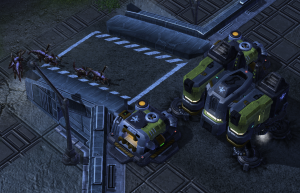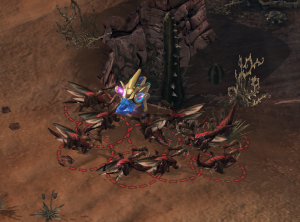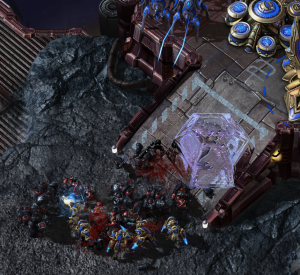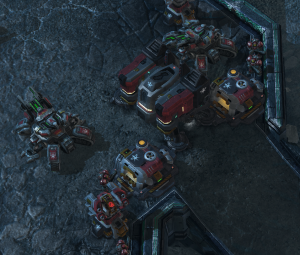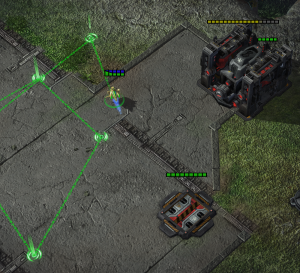Effective Harassment
Harassment is very exciting to watch in professional matches and can be great fun to emulate. Harassment is usually done to gain some sort of advantage through economic damage, disruption of production or by throwing off your opponent. While it seems like harassment would always be good sometimes you will do what seems like a lot of damage and still lose. There are a few things going on below the surface when top-tier players harass and there are some pitfalls to be aware of if you want your harassment to be effective.
Guaranteed Damage
The concept of guaranteed damage is important in harassment and even in normal attacks. You have probably noticed that when people harass they will try and kill workers, Pylons, Supply Depots or Overlords. The reasoning behind this seems kind of obvious, kill your opponents workers and they will be getting less income, kill their supply and they will become supply blocked. However, there is another level of reasoning at work here, guaranteed damage.
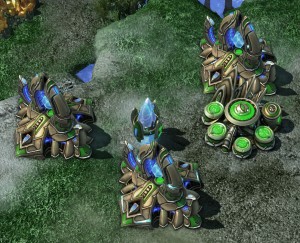
This Pylon is known as a 'critical Pylon' and it is a high priority target as it powers four structures.
Guaranteed damage simply means that you will be able to kill what you are trying to kill. If, for example, you drop a Medivac full or Marines in your Protoss opponents base you have a few choices and it may be tempting to go for the one with the biggest reward – the Nexus. However, it may take 30 seconds to kill the Nexus and in that time your units could be killed or repelled, leaving you with no damage done. If, you instead went for Probes or Pylons, which have much less health and are easier to kill, you will be almost guaranteed to do some damage before your opponent can defend.
It is essentially a question of risk vs reward, and you are always much safer going for an easier to obtain but smaller advantage then going for an unlikely to obtain but larger advantage. The following are a few examples of things to target when harassing with the concept of guaranteed damage in mind:
Vs. Protoss
- Probes – Economic damage and easy to kill.
- Pylons – Disrupts production by un-powering structures and affects supply cap. Single Pylons powering multiple buildings are high-priority targets.
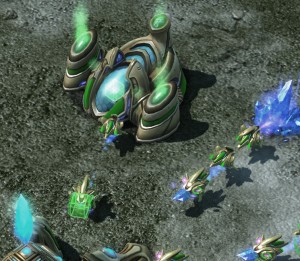
Workers mining gas are a good target as killing them can delay your opponents tech and some people will forget to replace them.
- SCVs – Economic damage, easy to kill and can not regenerate between multiple attacks.
- Mules – The same as SCVs but are higher priority due to the amount of minerals they harvest.
- Supply Depots – Affects supply, and relatively easy to kill.
- Tech Labs and Reactors – Have low health and killing them slows production or prevents higher tech units from being produced.
Vs. Zerg
- Drones – Economic damage and easy to kill.
- Overlords – Affects supply, easy to kill before speed upgrade and can often be found outside the bases of carless Zergs.
- Queens – Slow if caught off Creep, relatively easy to kill and slows down unit production greatly due to missed Larva Injects.
Two Places at Once
When harassing your opponent you never want to only attack one spot at a time. It is much easier for your opponent to defend, you are more likely to lose your units without doing any damage. A good example is sending a Medivac full of Hellions to attack your opponents main base. It is very easy for your opponent to pull back their army and kill off your attack before you have a chance to do any damage. If in that same scenario you sent Two Medivacs, one to the main and the other to the opponents third base your opponent may be able to easily defend one (simply retreat the attack that he tries to defend) but the other will go undefended. If instead your opponent splits his army and defends both Hellion drops they will be weak to a frontal assault. If they do neither then they will lose a lot of economy.
Another excellent way to incorporate multi-pronged harassments is to harass while attacking with you main army. While preoccupied with your frontal assault your harassment will likely go unnoticed and will cause a lot of damage. You can then simply retreat your main army and your harassment having doen the damage needed to secure a long-term victory.
Always be on the lookout for ways to spread your opponents resources thin, multi-pronged harassment will achieve this even if it does not actually do any damage. The threat of harassment can often be enough to secure you an advantage.

Frame by Frame example of a two pronged attack.
In the first frame the main army prepares to attack the opponents front while a Warp Prism full of Zealots prepares to drop at the east. In frame 2 the main army engages and the Warp Prism unloads in the mineral line. Having done the damage required to secure victory, the main army retreats in frame 3 to avoid unnecessary losses. Unfortunately the Warp Prism is destroyed preventing the Zealots from escaping but it was a worthwhile trade.
Takes the Opponents Focus
Good harassment will cause your opponent to make mistakes, to let their units get out position and to forget key parts of their build. The threat of harassment, like a Warp Prism sitting just outside their base can stress your opponent out or cause them to make more static defences then they would otherwise like to.
Doesn’t Put You Behind – Micro vs Macro
If your harassment taxes your own attention too much you will macro poorly and may even end up in a worse position than your opponent. Some harassment tactics require more micromanagement than others. Banshee harass and High Templar drops, for example, require a lot of attention and unless you are able to continue macro-ing whilst doing them they should be avoided by beginners.
However, there is no reason to not apply the same tactics to simpler harassment tactics. For example, attacking the front with your main army while running a few units to an unguarded expansion can be very effective in lower leagues.
Don’t Force it
The worst thing you can do is to overcommit to harassment. Don’t make harassment your main objective, and if your opponent is able to easily defend themselves then don’t try and force it. Each failed harassment attempt weakens your main army and makes you susceptible to a straight up attack. Incorporate harassment into your normal play while being aware of the above things and you will see a lot of success.
Have you had much success with harassment? Sometimes harassment tactics can seem very powerful and can win you games outright. But then there are other times when you appear to do a lot of damage but actually fall behind. Hopefully this article helps you understand some of the less-known aspects of the popular tactics.


